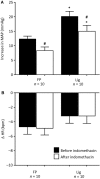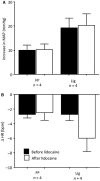Hindlimb venous distention evokes a pressor reflex in decerebrated rats
- PMID: 24907299
- PMCID: PMC4208660
- DOI: 10.14814/phy2.12036
Hindlimb venous distention evokes a pressor reflex in decerebrated rats
Abstract
The distention of small vessels caused by an increase in blood flow to dynamically exercising muscles has been proposed as a stimulus that activates the thin fiber (groups III and IV) afferents evoking the exercise pressor reflex. This theory has been supported by evidence obtained from both humans and animals. In decerebrated unanesthetized rats with either freely perfused femoral arteries or arteries that were ligated 3 days before the experiment, we attempted to provide evidence in support of this theory by measuring arterial pressure, heart rate, and renal sympathetic nerve discharge while retrogradely injecting Ringer's solution in increasing volumes into the femoral vein just as it excited the triceps surae muscles. We found that the pressor response to injection was directly proportional to the volume injected. Retrograde injection of volumes up to and including 1 mL had no significant effect on either heart rate or renal sympathetic nerve activity. Cyclooxygenase blockade with indomethacin attenuated the reflex pressor response to retrograde injection in both groups of rats. In contrast, gadolinium, which blocks mechanogated channels, attenuated the reflex pressor response to retrograde injection in the "ligated rats," but had no effect on the response in "freely perfused" rats. Our findings are consistent with the possibility that distension of small vessels within exercising skeletal muscle can serve as a stimulus to the thin fiber afferents evoking the exercise pressor reflex.
Keywords: Autonomic nervous system; dynamic exercise; peripheral artery disease; thin fiber muscle afferents.
© 2014 The Authors. Physiological Reports published by Wiley Periodicals, Inc. on behalf of the American Physiological Society and The Physiological Society.
Figures








References
-
- Adreani C. M., Kaufman M. P. 1998. Effect of arterial occlusion on responses of group III and IV afferents to dynamic exercise. J. Appl. Physiol.; 84:1827-1833. - PubMed
-
- Adreani C. M., Hill J. M., Kaufman M. P. 1997. Responses of group III and IV muscle afferents to dynamic exercise. J. Appl. Physiol.; 82:1811-1817. - PubMed
Grants and funding
LinkOut - more resources
Full Text Sources
Other Literature Sources

